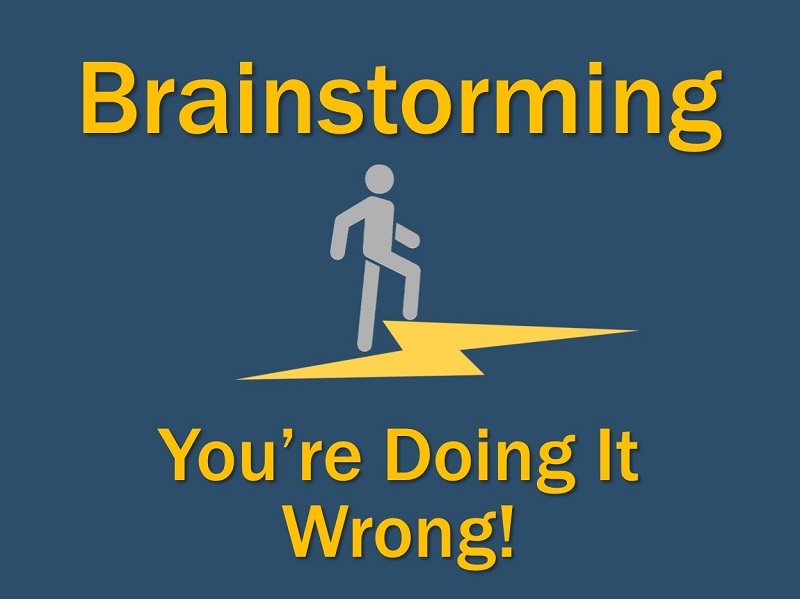In this Lightning Cast, we discuss brainstorming. You’ll realize that brainstorming doesn’t work – at least not the way you’re doing it. There’s a better way.
A Lightning Cast is a shorter form episode modeled after lightning talks. You’ll get valuable content in 8 minutes or less.
Critical to the success of any organization is the ability to creatively problem-solve and innovate. To do this, many people turn to brainstorming.
The problem is most people do it wrong. Even worse, there have been many studies that show that brainstorming doesn’t even work.
Let’s start with what we mean by brainstorming. The technique of brainstorming was introduced by advertising executive Alex Osborn in the 1950s. Osborn’s version of brainstorming has four rules:
- Focus on quantity by generating as many ideas as possible;
- Defer judgment by not criticizing or filtering ideas;
- Welcome unusual or innovative ideas; and
- Combine ideas and improve them
To start brainstorming, you identify the problem or situation that requires an innovative solution. You then get a group of people together to focus on the problem and shout out potential solutions. The facilitator records what people say so that the information is visible to everyone. Upon hearing or seeing other people’s ideas, you generate new ideas.
After the ideation portion, the group that thinks critically about the ideas to identify the most feasible solutions.
The premise is that together we can share our collective creative abilities and come up with more and better ideas than working alone. The diversity of thought leads to higher-quality solutions and better engagement by participants since they are all involved in coming up with a solution.
Unfortunately, Alex Osborne was wrong. There are plenty of studies that show that brainstorming leads to fewer ideas than working alone and that brainstorming can actually make groups less creative.
Why doesn’t brainstorming work?
One reason is because of what we call social loafing. That means that individuals in a group tend to put forth less effort than working alone. There’s a tendency to be more of a bystander than a strong contributor.
Social anxiety is another reason that brainstorming fails. It’s the fear of what others will think of your idea. This is especially true for introverted or less confident individuals.
Another issue is what we refer to as regression to the mean. This means that the diversity levels and creativity, skill, and knowledge in the group leads to just average thinking. The solutions from the most creative members will end up being at the same level as less creative members of the group. You’ve probably seen this in sports or other challenging competitions where if you practice with someone less skilled than you are, your competence level decreases/
Another problem with brainstorming is what we call ‘production blocking’. Because you shout out ideas one at a time and a facilitator needs to record those ideas, there is a delay in the free flow of ideas. Often when that happens, ideas that come in your head in a fleeting moment disappear and the number of creative ideas is limited,
Additionally, people often do brainstorming incorrectly when they fail to share the goal early. Often when you go into a brainstorming session, people are invited to the meeting without a clear idea what the goal or the problem they’re trying to solve is. This is really problematic for introverts because we like to think of ideas beforehand. Give people some time to think about the problem and let their subconscious mind work on the idea.
Other failures of brainstorming are the result of poor facilitation. Inexperienced facilitators may let the more outspoken people dominate the conversation. You need to make sure everyone has a voice and is free to express their opinions.
Also, the group may begin judging and filtering ideas which restricts the free flow of information. This is especially true if managers or other leaders are in the room.
Finally, there’s often bias in selecting ideas. As you conclude your divergent idea generation and begin to select the ideas that are most feasible, there’s often a bias. I want my solution to be one that’s selected.
If brainstorming doesn’t work, what does work?
There two approaches that I like to use: Brain Swarming and Brain Writing.
Brain Swarming was created by Dr. Tony McCaffrey and the approach is to start with the goal or problem statement which is made visible at the top of a whiteboard. You then list any resources that are available to address a problem at the bottom of the whiteboard. After the group understands the resources and the problem statement, they work independently by writing down their own ideas on Post-It notes.
Some people in the group will be big picture thinkers and start top-down by looking at the problem statement, helping to break that down further. The analytical, bottom-up thinkers will begin with the resources and start building those up to see how they could solve the problem. When the top-down thinkers in the bottom-up thinkers come together, that’s where the great solutions are formed.
By working independently and making things visible on the board as you write ideas on Post-Its, you get diversity of thought without all of the judgment and bias associated with it.
Similar to brain swarming, Leah Thompson from the Kellogg School of Management recommends a technique that she calls Brain Writing. Essentially, after everyone understands the goal or problem statement, each person in the group writes their own ideas silently on Post-It notes. After the ideas are written down, they’re all collected and the facilitator puts them all up on the wall. You then review all of those ideas and do multiple rounds of this individual writing. That way, people are able to spark new ideas and combined ideas to form new innovative solutions.
You can then take those ideas and bring in a new group to look at those ideas and identify which ones are most feasible. Bringing in a different group helps eliminate some of the judgment bias.
Brainstorming can generate a lot of ideas, but they might not be the right ideas. Instead, start using techniques and methods that help generate better and more useful ideas.
Listen to this lightning cast to understand better ways of creative problem solving.
Thank you for listening to the program
To get more valuable content to enhance your skills and advance your career, you can subscribe on iTunes and other podcatchers.
Also, reviews on iTunes are highly appreciated! I read each review and it helps keep me motivated to continue to bring you valuable content each week.







